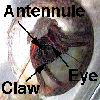Carnivores and Saprophages
Be sure to write about what you are learning in the lab section of your notebook. You will be expected to answer questions about the lab activity during the lab self test and lab quiz. It helps to have your text and coloring books open beside you for support.
| Refer to the Assigned Readings Below: | |
| Marine Biology Textbook | Chapter 10, page 219 to 220 |
| Marine Biology Coloring Book | Plate 23, 31, 36, and 108 |
Predators
Predators are animals which capture, kill and consume other organisms which are called prey. The prey organism can be of any type. Predators are classified by the type of prey they cconsume.
Carnivores
Predators that eat other animals are called carnivores. There are two types of carnivores: attackers and ambushers. Attackers or pursuing carnivores "run down" their prey. They are highly active with acute senses for detecting and capturing prey. Ambushers or sit-and-wait carnivores remain in one place and wait for prey to come to them. They must remain perfectly still and are often camlouflaged so that prey animals will not see them until it is to late. Some ambushers rush out of hiding to grab their prey but some are actually attached to the bottom and to get a meal their prey must blunder into them. These attached ambushers are often slow to move and lack sense organs.
|
Sea Anemones
|
|
| Sea anemones are ambush carnivores that eat small crustaceans that swim into them unsuspectingly. They creep slowly along the bottom on their pedal disc and have a series of tentacles that surround their mouths. The tentacles are armed with stinging cells called nematocysts and are used to capture prey. Each nematocyst acts as a tiny harpoon that injects poison and paralyzes the prey. The tentacles move the helpless prey into the mouth. | |
Experimental
Set Up:
|
|
|
Observations:
|
|
Saprophages
Saprophages are organisms which consume dead and decaying organic matter. The source of the organic matter is the bodies or parts of previously living organisms. Saprophages are classified by the types of organic matter they consume.
Scavengers
Scavengers are animals that eat the corpses of animals or plants. They are often active animals with acute senses. To find the rare corpse a scavenger must search over relatively large areas and detect their food from a distance. They must locate their food quickly before other scavengers beat them to it.
|
Mud Snails
|
|
|
Mud snails are scavengers that live in mudflats near shore. They have a long extensible siphon that is used to conduct water into their shell cavity which contains their gills and a sense organ called an osphradium. They spend a great deal of their time buried in the mud with their siphons sticking out into the seawater. When they detect a corpse they will leave the mud and crawl to it to feed. |
|
Experimental
Set Up:
|
|
|
Observations:
|
|
Detritivores
Detritivores are animals that eat organic fragments called detritus. Detritus is formed when dead plants and animals are broken down into tiny bits. The detrital particles are often mixed with sediments and must be collected by the detritivore. Detritivores remove detritus from sediments in different ways. Deposit feeding detritivores swallow the sediments, digest the organics and pass the undigestible sediment as feaces. Selective deposit feeders pick the detritus out of the sediments and eat it.
|
Hermit Crabs
|
|
|
Hermit crabs are selective deposit feeders. They will move over the sediments and pick up detrital particles and place them in their mouth parts. The mouth parts are used to remove any remaining sediments before the detritus is swallowed. |
|
Experimental
Set Up:
|
|
|
Observations:
|
|


